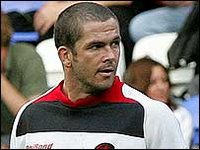Farrell Transfer Has England Out of Position
 In the rather calamitous three years that English rugby union has endured since winning the World Cup in Australia, the messy nature of Andy Farrell's recruitment from rugby league by the RFU is both the latest trough and a pertinent encapsulation of many of English rugby's problems. It also provides another twist in the long-running saga of moves between rugby's two codes.
In the rather calamitous three years that English rugby union has endured since winning the World Cup in Australia, the messy nature of Andy Farrell's recruitment from rugby league by the RFU is both the latest trough and a pertinent encapsulation of many of English rugby's problems. It also provides another twist in the long-running saga of moves between rugby's two codes.Farrell's capture was firstly problematic due to the Wigan and Great Britain player's age: he had his 31st birthday last May. No callow, impressionable youth, Farrell was being asked to make the transition - and familiarise himself with the differing skills and disciplines of union - in double-quick time, were value to be accrued to the RFU and his new club, Saracens, following his costly recruitment.
More importantly, and the issue which has caused the latest club versus country antagonism in England, is that his natural position in union did not appear obvious. Farrell played as a loose forward in league, but the absence of a meaningful scrum or anything similar to union's 'breakdown' in that code meant that he could in no way seamlessly transfer to union's equivalent.
Alternatively, it was suggested that he be used as an inside centre; indeed, this was the position in which England coach Andy Robinson - starved as he is of much back-line explosiveness - hoped to use him. Physically, a case could be made for him in either position: brawny enough to play in the forwards, mobile enough to play in the back line position which most requires a bit of beef.
However, while Robinson saw him breaking from midfield, Alan Gaffney, the former Munster coach now Saracens' director of rugby, believes his best position to be as blind-side flanker. Farrell, who has been sidelined with injury problems since his switch to union, was sent back to his club from England's elite training camp yesterday in order to gain much-needed game-time in their Anglo-Welsh Cup game against Cardiff Blues on Sunday.
Meanwhile Robinson is due to meet Gaffney today to reach some sort of agreement on Farrell's position - although it might be more apt to suggest that Robinson hopes to force Saracens to toe the RFU line on the matter.
This part of the Farrell situation is hugely indicative of one of English rugby's problems. With the RFU putting up £700,000 of the approximately £1m deal, the union is clearly irritated at the latest example of a club - which, in English rugby, are independent entities from the union, unlike Ireland's IRFU-affiliated provincial structure - exercising its individuality.
The strength of the clubs has been seen as hindering the progress of the national team, with the union possessing much less power to prevent players lining out for their clubs in the run-up to international fixtures than is the case in Ireland. Robinson is bearing witness to the clubs' primacy right now, with scores of players on treatment tables as England begin preparations for the November internationals and the visit of the All Blacks.
The Farrell issue has also brought generated some audible harrumphs from the RFU and, no doubt, some schadenfreude from their league brethren. Francis Baron, chief executive of the RFU, obviously peeved at the thus-far monumentally botched Farrell transfer, stated that the RFU would never again fund such a move unless there is an unaswerable case to do so.
"We've got to be clear how the player is going to fit into the England set-up before he makes the move. What we could have done better is to align the clubs' and England's view as to how he can best be integrated," said Baron two days ago. The inference that the Farrell transfer was a 'panic-buy' - an inference voiced outright by former England prop Jeff Probyn - is clear, as is a swipe at the lack of cooperation which Saracens have provided on the matter.
Whether this transfer will have burned union officials to the extent of stemming the flow of players moving from league to union is unclear. For every Farrell, Iestyn Harris and Henry Paul whose transitions were either difficult or failed, there are success stories like Jason Robinson, Mat Rogers and Lote Tuquiri, never mind Jonathan Davies, who went from union to league and back again.
However, with two young league players (Chev Walker, Leeds Rhinos to Bath; Karl Pryce, Bradford to Gloucester) having made the switch over the recent close season and possibly more to follow, it seems that, despite the problems with Andy Farrells's move, rugby union apparently remains keen to do business with its friends in the north.






0 Comments:
Post a Comment
<< Home